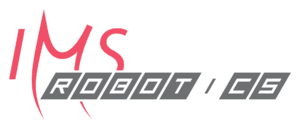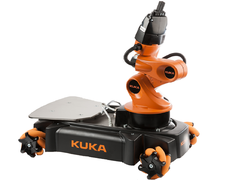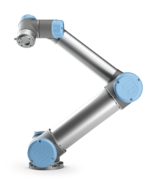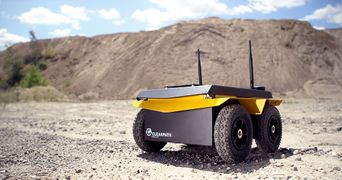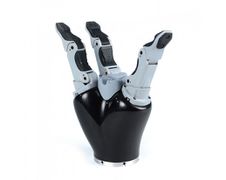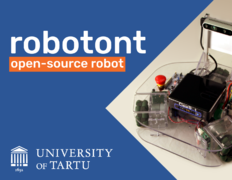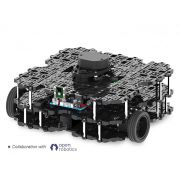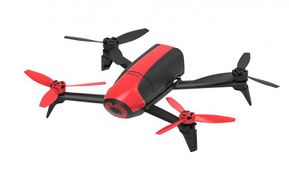Robotics: Difference between revisions
| Line 73: | Line 73: | ||
=== Selected publications === | === Selected publications === | ||
* Robert Valner, Houman Masnavi, Igor Rybalskii, Rauno Põlluäär, Erik Kõiv, Alvo Aabloo, Karl Kruusamäe, Arun Kumar Singh (2022) {{doi-inline|10.3389/frobt.2022.922835|Scalable and heterogenous mobile robot fleet-based task automation in crowded hospital environments—a field test}}, ''Frontiers in Robotics and AI'' '''9''', 922835. | * Robert Valner, Houman Masnavi, Igor Rybalskii, Rauno Põlluäär, Erik Kõiv, Alvo Aabloo, Karl Kruusamäe, Arun Kumar Singh (2022) {{doi-inline|10.3389/frobt.2022.922835|Scalable and heterogenous mobile robot fleet-based task automation in crowded hospital environments—a field test}}, ''Frontiers in Robotics and AI'' '''9''', 922835. | ||
* Masnavi, H., Shrestha, J., Mishra, M., Sujit, P.B., Kruusamae, K., Singh, A.K. (2022) {{doi-inline|10.1109/LRA.2022.3190087|Visibility-Aware Navigation With Batch Projection Augmented Cross-Entropy Method Over a Learned Occlusion Cost}}, IEEE Robotics and Automation Letters. | * Masnavi, H., Shrestha, J., Mishra, M., Sujit, P.B., Kruusamae, K., Singh, A.K. (2022) {{doi-inline|10.1109/LRA.2022.3190087|Visibility-Aware Navigation With Batch Projection Augmented Cross-Entropy Method Over a Learned Occlusion Cost}}, ''IEEE Robotics and Automation Letters'' '''7'''(4), 9366 - 9373. | ||
* Robert Valner, Veiko Vunder, Alvo Aabloo, Mitch Pryor, Karl Kruusamae (2022) {{doi-inline|10.1109/access.2022.3173647|TeMoto: A Software Framework for Adaptive and Dependable Robotic Autonomy With Dynamic Resource Management}}, IEEE Access. | * Robert Valner, Veiko Vunder, Alvo Aabloo, Mitch Pryor, Karl Kruusamae (2022) {{doi-inline|10.1109/access.2022.3173647|TeMoto: A Software Framework for Adaptive and Dependable Robotic Autonomy With Dynamic Resource Management}}, ''IEEE Access'' '''10''', 51889 - 51907. | ||
* Robert Valner, Jason Mario Dydynski, Sookyung Cho, Karl Kruusamäe (2021) {{doi-inline|10.1177/0018720820902293|Communication of Hazards in Mixed-Reality Telerobotic Systems: The Usage of Naturalistic Avoidance Cues in Driving Tasks}}, ''Human Factors: The Journal of the Human Factors and Ergonomics Society'' '''63'''(4), 619-634. | * Robert Valner, Jason Mario Dydynski, Sookyung Cho, Karl Kruusamäe (2021) {{doi-inline|10.1177/0018720820902293|Communication of Hazards in Mixed-Reality Telerobotic Systems: The Usage of Naturalistic Avoidance Cues in Driving Tasks}}, ''Human Factors: The Journal of the Human Factors and Ergonomics Society'' '''63'''(4), 619-634. | ||
* Veiko Vunder, Robert Valner, Conor McMahon, Karl Kruusamäe, Mitch Pryor (2018) {{doi-inline|10.1109/HSI.2018.8431062|Improved Situational Awareness in ROS using Panospheric Vision and Virtual Reality}}, ''2018 11th International Conference on Human System Interaction (HSI)'', 471 - 477. | * Veiko Vunder, Robert Valner, Conor McMahon, Karl Kruusamäe, Mitch Pryor (2018) {{doi-inline|10.1109/HSI.2018.8431062|Improved Situational Awareness in ROS using Panospheric Vision and Virtual Reality}}, ''2018 11th International Conference on Human System Interaction (HSI)'', 471 - 477. | ||
Revision as of 10:22, 29 December 2022
Goal and motivation for robotics at IMS Lab
Robots are developed for improving the quality of our lives. Human-Robot Collaboration encompasses developing usable robots that make our everyday lives easier. Collaborative robots share their autonomy with human partners, thus improving the efficiency and quality of work in areas such as flexible manufacturing, logistics, domestic assistance, healthcare, and teleoperation in hazardous environments. We have extensive experience in research and technology of every aspect of robotics: designing electronics, mechanical engineering, software development, system integration, device building, education, and training.
Highlights
- TeMoto, framework for dependable robotics,
- omnidirectional robotont platform for education and research in ROS,
- Fits.me shape-changing mannequin,
- Self-deployable Habitat for Extreme Environments (SHEE),
- Massive open online course (MOOC) about robotics in Estonia (https://sisu.ut.ee/robot).
Capabilities
Equipment
Our inventory includes but is not limited to:
- MiR
- Robotiq 2F
- ClearBot
- OSVR
- Oculus Rift
- Intel RealSense, Kinect, Leap Motion Controller, Ouster OS-1
Skills
- ROS (Robot Operating System)
- Full robotics system development
- Hardware integration
- Process automation
- Motion planning and control theory
- System identification
- Data fusion
- Electronics design
- Simulations and digital twins
- Algorithm development
- Scientific publication
- ROS and engineering trainings
Primary contact
Student projects
We always welcome new motivated students who are interested in robotics to join our team. We offer student projects on the following general topics:
- intuitive teleoperation interfaces,
- collaborative robotics for flexible manufacturing,
- autonomous ground vehicles,
- autonomous drones
- robotics education.
A list of potential student projects in robotics or soft robotics.
Portfolio
Selected projects
- TeMoto - framework for building dependable robotic applications for facilitating human-robot collaboration and autonomy (in collaboration with the Nuclear and Applied Robotics Group at UT-Austin).
- Yanu - fully autonomous robot empowered bartending unit
- robotont - open source omnidirectional mobile robot platform
- SHEE - Self-deployable Habitat for Extreme Environments, aka "the Mars house"
Selected publications
- Robert Valner, Houman Masnavi, Igor Rybalskii, Rauno Põlluäär, Erik Kõiv, Alvo Aabloo, Karl Kruusamäe, Arun Kumar Singh (2022) Scalable and heterogenous mobile robot fleet-based task automation in crowded hospital environments—a field test, Frontiers in Robotics and AI 9, 922835.
- Masnavi, H., Shrestha, J., Mishra, M., Sujit, P.B., Kruusamae, K., Singh, A.K. (2022) Visibility-Aware Navigation With Batch Projection Augmented Cross-Entropy Method Over a Learned Occlusion Cost, IEEE Robotics and Automation Letters 7(4), 9366 - 9373.
- Robert Valner, Veiko Vunder, Alvo Aabloo, Mitch Pryor, Karl Kruusamae (2022) TeMoto: A Software Framework for Adaptive and Dependable Robotic Autonomy With Dynamic Resource Management, IEEE Access 10, 51889 - 51907.
- Robert Valner, Jason Mario Dydynski, Sookyung Cho, Karl Kruusamäe (2021) Communication of Hazards in Mixed-Reality Telerobotic Systems: The Usage of Naturalistic Avoidance Cues in Driving Tasks, Human Factors: The Journal of the Human Factors and Ergonomics Society 63(4), 619-634.
- Veiko Vunder, Robert Valner, Conor McMahon, Karl Kruusamäe, Mitch Pryor (2018) Improved Situational Awareness in ROS using Panospheric Vision and Virtual Reality, 2018 11th International Conference on Human System Interaction (HSI), 471 - 477.
- Karl Kruusamäe, Mitch Pryor (2016) High-precision telerobot with human-centered variable perspective and scalable gestural interface, 2016 9th International Conference on Human System Interactions (HSI), 190-196.
Outreach
- Massive open online course (MOOC) about robotics in Estonian (https://sisu.ut.ee/robot).
- Professional ROS trainings in Estonia
- School Robotics
